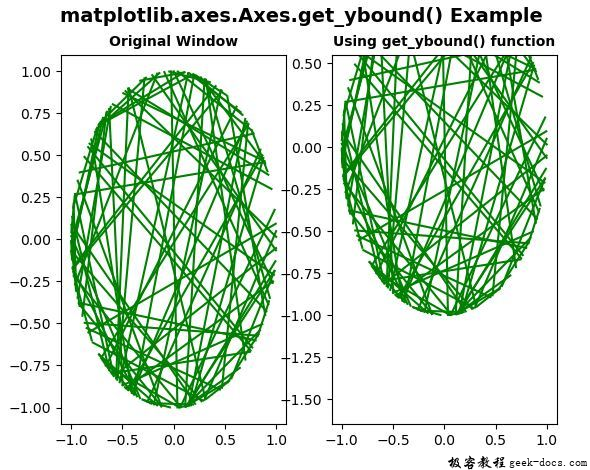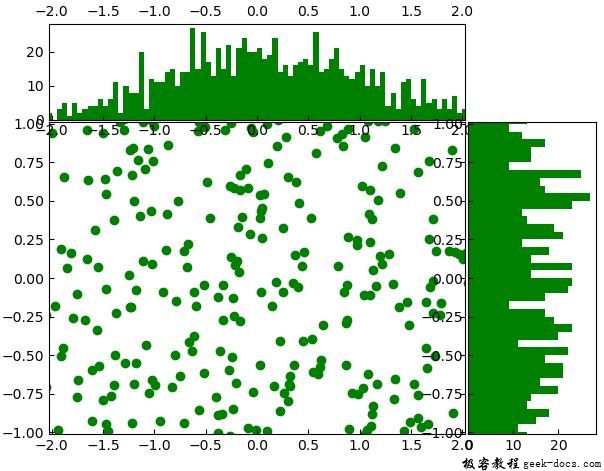Matplotlib.axes.axes.get_ybound()
Matplotlib是Python中的一个库,它是NumPy库的数值-数学扩展。Axes包含了大多数图形元素:Axis、Tick、Line2D、Text、Polygon等,并设置坐标系。Axes的实例通过callbacks属性支持回调。
matplotlib.axes.axes.get_ybound()函数
matplotlib库的Axes模块中的Axes.get_ybound()函数用于按递增顺序返回y轴的数值下界和上界
语法:Axes.get_ybound(self)
参数:该方法不接受任何参数。
该方法返回以下内容
- lower, upper:返回当前的y轴上下边界。
注意:这个函数可以在各种情况下代替get_ylim。
下面的例子演示了matplotlib.axes.axes.get_ybound()函数在matplotlib.axes中的作用:
示例1
# Implementation of matplotlib function
import numpy as np
import matplotlib.pyplot as plt
fig, (ax, ax1) = plt.subplots(1, 2)
t = 3*(np.random.rand(2, 100) - .5)
x = np.cos(2 * np.pi * t)
y = np.sin(2 * np.pi * t)
ax.plot(x, y, 'g')
lower, upper = ax.get_ybound()
ax.set_title('Original Window',
fontsize = 10, fontweight ='bold')
ax1.plot(x, y, 'g')
ax1.set_ybound(1.5 * lower, 0.5 * upper)
ax1.set_title('Using get_ybound() function',
fontsize = 10, fontweight ='bold')
fig.suptitle('matplotlib.axes.Axes.get_ybound() Example\n',
fontsize = 14, fontweight ='bold')
plt.show()
输出:

示例2
import numpy as np
import matplotlib.pyplot as plt
# Fixing random state for reproducibility
np.random.seed(19680801)
# the random data
x = np.random.randn(1000)
y = np.random.randn(1000)
# definitions for the axes
left, width = 0.1, 0.65
bottom, height = 0.1, 0.65
spacing = 0.005
rect_scatter = [left, bottom, width, height]
rect_histx = [left,
bottom + height + spacing,
width, 0.2]
rect_histy = [left + width + spacing,
bottom, 0.2, height]
# start with a rectangular Figure
plt.figure()
ax_scatter = plt.axes(rect_scatter)
ax_scatter.tick_params(direction ='in',
bottom = True,
right = True)
ax_histx = plt.axes(rect_histx)
ax_histx.tick_params(direction ='in',
labeltop = True)
ax_histy = plt.axes(rect_histy)
ax_histy.tick_params(direction ='in',
labelleft = True)
# the scatter plot:
ax_scatter.scatter(2 * x, y * 2, color ="green")
# now determine nice limits by hand:
binwidth = 0.05
lim = np.ceil(np.abs([x, y]).max() / binwidth) * binwidth
ax_scatter.set_xbound((-0.5 * lim, 0.5 * lim))
ax_scatter.set_ybound((-0.25 * lim, 0.25 * lim))
bins = np.arange(-lim, lim + binwidth, binwidth)
ax_histx.hist(x, bins = bins,
color ="green")
ax_histy.hist(y, bins = bins,
color ="green",
orientation ='horizontal')
ax_histx.set_xbound(ax_scatter.get_xbound())
ax_histy.set_ybound(ax_scatter.get_ybound())
plt.show()
输出:

 极客教程
极客教程